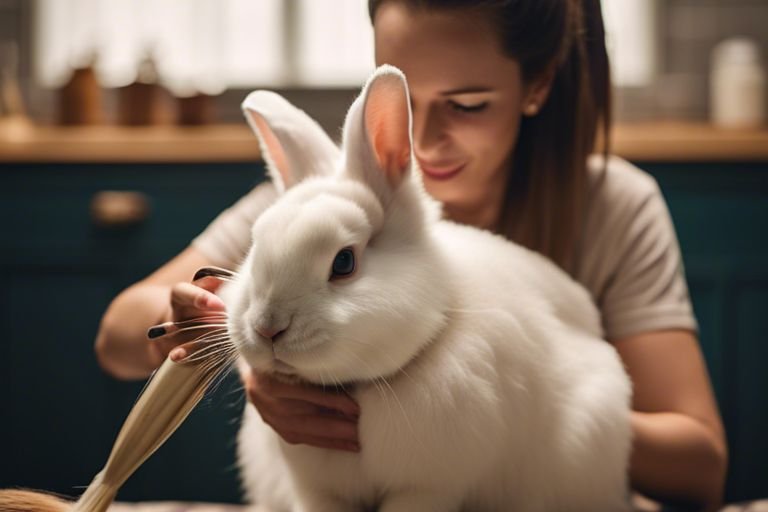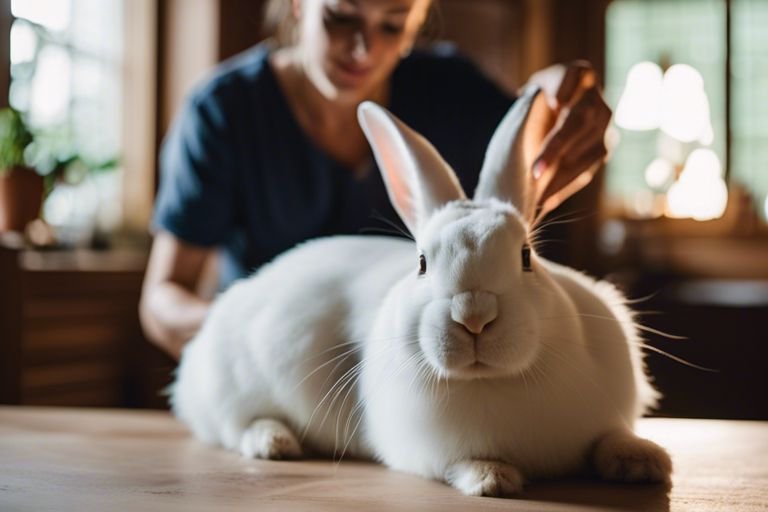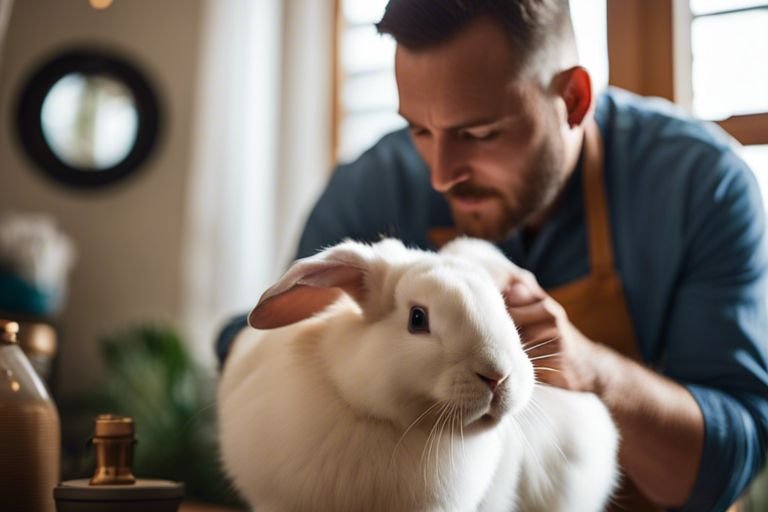Experiencing the molting process with your Flemish Giant rabbit can be an overwhelming experience. These massive rabbits shed a substantial amount of fur, which can lead to various issues if not properly managed. Understanding how to effectively deal with shedding in Flemish Giant rabbits is crucial to ensure their health and well-being. By implementing the right strategies, you can minimize the impact of shedding and keep your rabbit happy and healthy.
Key Takeaways:
- Regular grooming is essential: Brush your Flemish Giant rabbit at least once a week to remove loose fur and prevent matting.
- Provide a balanced diet: Ensure your rabbit is receiving a proper diet with enough fiber to support their digestive health, which can in turn reduce shedding.
- Minimize stress: Rabbits can shed excessively when stressed, so create a calm and comfortable environment for your Flemish Giant.
- Consult a veterinarian: If you notice abnormal shedding or bald patches, seeking professional advice is crucial to rule out any underlying health issues.
- Use preventive measures: Regularly check for any signs of mites or fleas, and use appropriate preventive treatments to minimize shedding.
Factors Influencing Shedding
Now, shedding in Flemish Giant rabbits can be influenced by various factors. Understanding these factors can help you manage and minimize shedding effectively. Some of the key factors to consider include breed characteristics, health and nutrition, and seasonal changes.
Breed Characteristics
Shedding in Flemish Giant rabbits is influenced by their breed characteristics. These rabbits are known for their large size and thick, dense fur. As a result, they tend to shed more than smaller rabbit breeds. The length and texture of their fur also play a role in the shedding process. Understanding the typical shedding patterns of Flemish Giant rabbits can help you prepare for and manage their shedding effectively.
Health and Nutrition
Characteristics such as overall health and nutrition can significantly impact the shedding of Flemish Giant rabbits. A balanced diet, rich in essential nutrients, can promote healthy fur growth and reduce excessive shedding. Similarly, underlying health issues can contribute to abnormal shedding patterns. Regular veterinary check-ups and a proper diet are essential to maintain the overall health and coat quality of your Flemish Giant rabbits.
With proper grooming and nutrition, you can effectively manage shedding in Flemish Giant rabbits. Providing a high-quality diet and ensuring proper grooming practices are essential for maintaining healthy fur and minimizing shedding.
Seasonal Changes
Factors such as seasonal changes can also impact the shedding patterns of Flemish Giant rabbits. Rabbits may shed more during certain seasons, such as spring and fall, as part of their natural molting process. Understanding these seasonal changes can help you anticipate and manage shedding effectively.
Breed characteristics, such as the thick fur of Flemish Giant rabbits, can cause them to shed more during certain seasons. This shedding is a natural process that helps them adapt to changes in temperature and daylight hours.

How-To Guide for Grooming
Keep your Flemish Giant rabbit’s shedding under control with our comprehensive grooming guide. By following these simple steps, you can ensure that your rabbit’s coat remains healthy and free from shedding issues.
Regular Brushing Techniques
Guide your grooming routine by regularly brushing your Flemish Giant rabbit’s coat with a gentle slicker brush. Start by brushing in the direction of hair growth, focusing on one section at a time. Use a light touch to avoid causing any discomfort to your rabbit, and be sure to remove any loose fur as you go. Regular brushing not only helps to prevent excessive shedding, but it also promotes healthy circulation and can reduce the risk of hairballs.
Appropriate Grooming Tools
Regularly maintaining your Flemish Giant rabbit’s coat requires the right grooming tools. A slicker brush is essential for removing loose fur and preventing matting, while a flea comb can help to remove any stubborn knots or tangles. Additionally, a pair of blunt-tipped scissors can be useful for trimming any stray hairs, especially around the ears and hindquarters. By investing in the right grooming tools, you can effectively manage your rabbit’s shedding and keep their coat in top condition.
Grooming is an essential part of caring for a Flemish Giant rabbit, especially when it comes to managing shedding. With the right tools and techniques, you can keep your rabbit’s coat looking and feeling its best, while also preventing any potential health issues related to excessive shedding. Be sure to prioritize regular grooming sessions to maintain your rabbit’s coat, and always handle grooming tools with care to avoid any accidental injuries.
Tips for a Shedding-Proof Home
Unlike other animals, Flemish Giant rabbits have a tendency to shed a lot of fur, especially during certain times of the year. To keep your home shedding-proof, consider these tips:
- Regular grooming sessions to remove loose fur
- Use a high-quality brush designed for rabbit fur
- Invest in a good vacuum cleaner to remove loose fur from carpets and furniture
- Wash rabbit bedding and blankets frequently to remove loose fur
The 6 Reasons for Excessive Shedding in Rabbits and Treatment article offers valuable insights into understanding and managing excessive shedding in rabbits.
Cleaning Strategies
For a shedding-proof home, implement a regular cleaning schedule to remove loose fur and dander. Vacuuming carpets and furniture, sweeping floors, and washing rabbit bedding can help minimize the buildup of fur in the home. Additionally, using lint rollers and pet hair removers on fabric surfaces can further reduce the presence of rabbit fur.
Creating a Rabbit-Friendly Environment
Environment plays a crucial role in managing shedding in Flemish Giants. Optimize the living space for your rabbit by providing ample room for exercise and a healthy diet to promote overall wellness. Creating a comfortable and stress-free environment can help reduce excessive shedding in rabbits.
A well-maintained living space with proper ventilation and natural lighting can contribute to a healthier coat and reduced shedding in Flemish Giant rabbits. Additionally, incorporating safe chew toys and enrichment activities can help minimize stress and promote healthy fur growth.

Conclusion
So when it comes to dealing with shedding in Flemish Giant rabbits, it’s important to remember that regular grooming and a healthy diet are key. Brushing your rabbit’s coat daily can significantly reduce shedding and prevent matting, while providing a diet rich in hay and vegetables will ensure their fur stays healthy. Additionally, controlling the temperature and the humidity in their environment can help minimize shedding. By following these tips and techniques, you can keep your Flemish Giant rabbit’s shedding under control and maintain a happy, healthy pet.
FAQ
Q: Why do Flemish Giant rabbits shed?
A: Flemish Giant rabbits shed as part of their natural growth cycle. Shedding helps them remove old or damaged fur to make way for new, healthy fur to grow in.
Q: How can I minimize shedding in my Flemish Giant rabbit?
A: Regular grooming is key to minimizing shedding in Flemish Giant rabbits. Brushing them at least once a week helps remove loose fur and prevents it from accumulating in their coat. Additionally, providing a balanced diet and regular exercise can also contribute to a healthy coat and decreased shedding.
Q: When should I be concerned about shedding in my Flemish Giant rabbit?
A: While shedding is a normal process for rabbits, excessive shedding or unusual patterns of shedding can be cause for concern. If you notice bald patches, skin irritation, or a dramatic increase in shedding, it may be a sign of an underlying health issue such as mites, fungal infections, or dietary deficiencies. In these cases, it’s important to consult with a veterinarian for proper diagnosis and treatment.
